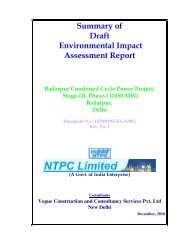proposed integrated complex for delhi judicial academy
proposed integrated complex for delhi judicial academy
proposed integrated complex for delhi judicial academy
You also want an ePaper? Increase the reach of your titles
YUMPU automatically turns print PDFs into web optimized ePapers that Google loves.
Rapid Environmental Impact Assessment (REIA) Study <strong>for</strong> Proposed Integrated Complex <strong>for</strong> Delhi Judicial Academy,<br />
National Law School, and National Institute <strong>for</strong> Mediation & Conciliation at Dwarka, New Delhi<br />
The environmental impacts in this section have, as such, been discussed separately <strong>for</strong> the<br />
construction phase and the operation stages of the <strong>proposed</strong> project.<br />
The environmental impact assessment approach used to evaluate the <strong>proposed</strong> project comprises of<br />
three sequential elements. These are impacts identification, prediction and evaluation.<br />
The first step of the impact assessment process involves identifying the key issues associated with<br />
the construction and operation phases of the project. Issues and concerns of the <strong>proposed</strong> project<br />
are scoped based on the knowledge and experience with respect to environmental setting and<br />
project elements. Accordingly, the existing environmental system is described and the components<br />
of the project are determined.<br />
This step involves identification of the environmental modification that may be significant,<br />
<strong>for</strong>ecasting of the quality and spatial dimension of change in the environment identified and<br />
estimation of the probability that the impact will occur.<br />
This step involve determination of the incidence of benefit to user groups and population affected<br />
by the project, specification and comparison of effects between various alternatives, and assessment<br />
of the likely effect of the project on the environmental, economical and social components<br />
indicating the nature of effects.<br />
5.2 Impacts on Ambient Air Environment<br />
The potential ambient air quality impacts arising from the <strong>proposed</strong> project would occur mainly<br />
during project construction phase. Suspended Particulate Matter (SPM) and Respirable Particulate<br />
Matter (RPM) would be the predominant pollutant generated from construction activities. The<br />
gaseous emissions such as SO 2 , NOx and CO would be generated from the construction equipments<br />
and vehicles. During operation phase, DG sets would be the only point source of emission.<br />
The ambient air quality monitoring results show that the SPM and RPM concentrations at most of<br />
the locations within the core zone of the <strong>proposed</strong> project site are close to the norms prescribed <strong>for</strong><br />
the residential areas. However, appropriate mitigation measures would still be employed during the<br />
construction stage to reduce any incremental rise in pollution level to an acceptable limit.<br />
98
















